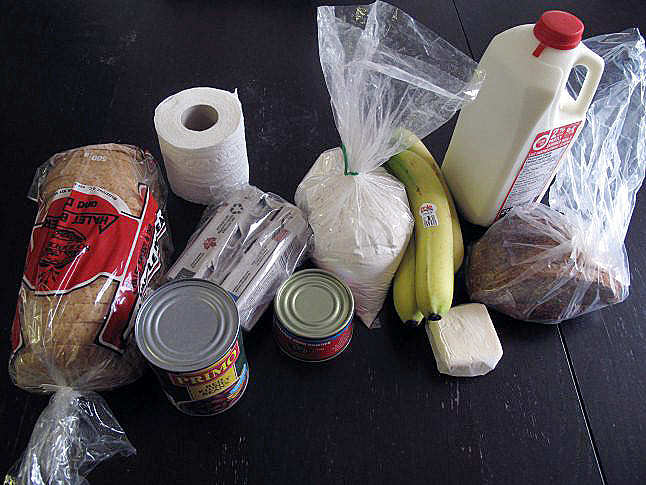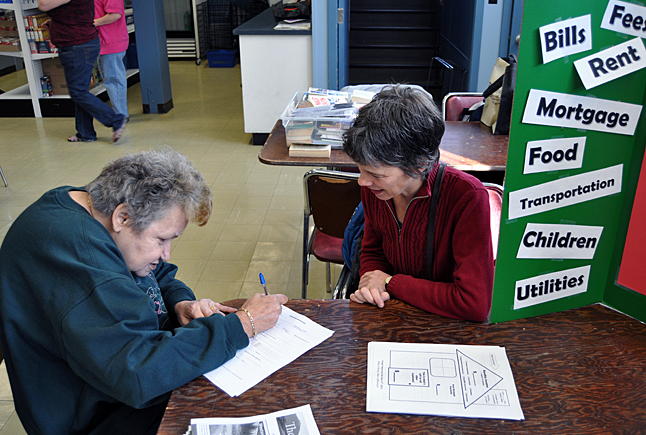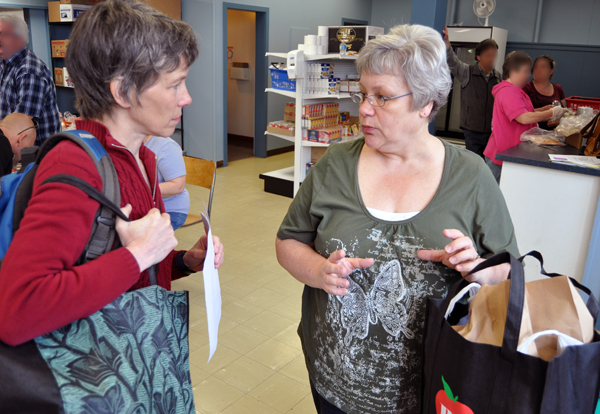
Editor’s Note:
Over the last 10 years the Food Bank that some thought would be a temporary agency has become institutionalized and necessary to a great many people. Yet for all that it remains a mystery of sorts and the subject of rumours and innuendo.
With National Hunger Awareness Day, May 31, approaching The Current decided to explore the Food Bank by tasking writer Laura Stovel with writing about it from a new angle.
The result — the first in a series of stories — is below. Enjoy:
In the Food Bank line-up
By Laura Stovel
It’s 8:15 on a Friday morning and I’ve just joined the line at the side door of the Legion Hall that leads to the Food Bank. Fifteen minutes to go before the Food Bank opens and there are already 11 men and five women, cloth bags in hand, waiting patiently in the queue.
Some women up front chat quietly. Another woman rides by on a bicycle and stops to talk with a friend. But the men are mostly silent and a little restless; the man behind me marks time on the pavement by spitting the occasional sunflower seed shell. They are waiting for the most publicly visible part of the trip to the Food Bank to end and the blue door to swing open.
When the door does open, it reveals a set of stairs leading down to a small hall lined on one side with tables stacked with food; cheerful volunteers stand behind them. Milk, eggs, bread, tuna and welcome stacks of romaine lettuce and bananas are all arranged neatly. The awkwardness of standing outside is forgotten and I see this food with a rush of relief and gratitude.
It is my first time at the food bank and I don’t know what to expect. When I agreed to do this assignment for Current editor David Rooney – to eat for a week off a food bank hamper and a minimal food budget – I wondered how this would affect the way I cook. Would I be tied to pre-prepared foods – canned soups and stews, for example – or would there be basic ingredients that would allow me some flexibility? I see with relief that the food includes many staples. I’ll be fine.
The room has a friendly, warm atmosphere and the line to sign in or – as in my case – register has suddenly become quite full. Though there is a young couple with a baby in a stroller and at least one single parent collecting food to keep her teenage sons going for the week, I am struck again by the number of older men, at least in their 40s. There are also quite a number of people with disabilities. I know this is a room full of stories.

When I reach the registration desk, Karen, a volunteer, takes me aside to register me. She writes my name, civic address and contact information, including an emergency contact. She also asks me about my source of income and requests an income record. This is hard. I, like many people in Revelstoke, work many small jobs to make ends meet. This is not a town where well-paying jobs come easily. Karen is flexible with this question and explains that Community Connections, which runs the Food Bank, has other resources that can help people in financial difficulty in addition to the food bank. She hands me information that explains the Food Bank services and schedule.

Once I am registered I pull out my cloth bag and volunteers fill it up as I pass. I am offered two loaves of bread and two packages of margarine but I only take one of each. Volunteers give me a two-litre jug of milk, a can of tuna and a package of breakfast sausages. The lettuce is gone – a good reason for people to arrive early – but there are still bananas and some hearty frozen multigrain bread left that I gratefully accept. We are allowed to ask for two items from the final table. I request a can of kidney beans and a small bag of white flour.
After I’ve finished, Food Bank coordinator Patty Larson takes me aside and offers me a food hamper. Today is a weekly distribution day, but once a month clients are also given a food hamper, designed to last three to four days. The food hampers will be distributed next Friday but Patty is giving me mine a week early.
Once again I am pleased and amazed at what the Food Bank is able to provide. The hamper includes dried spaghetti, coffee, tea, toilet paper, soap, sugar, apple juice, a tin of vegetables and another can of tuna. There is also tinned stew, tinned baked beans and two cans of tomato soup. Patty explains that we are allowed to substitute some items so I exchange the latter tinned items for tinned tomatoes, which I plan to use with the kidney beans to make a vegetarian chili.

These substitutions are very important, not only to recognize the dignity and individuality of recipients, but also because some recipients have severe food allergies. One family of recipients has many food severe allergies and the mother has to go through all food labels to make sure that her family can eat the food provided.
After I have collected my food packages I take a few moments to absorb the atmosphere and talk with clients, some of whom are also volunteers. I was especially interested in the circumstances of some of the men who received food here and in how and what they ate. Perhaps it is my sociology background but I am beginning to see a possible difference between men and women in relation to poverty and food, a theme that I hope to explore in later articles.
One theme that did emerge from my conversations with two men receiving food was the importance of meat in their diet. Both loved meat and made it a part of two, if not three meals a day. Other than the breakfast sausages and the tinned fish and stew, the Food Bank does not provide much meat so these men found they spent a fair amount of their food budget on meat.
After I left the food bank I went to the grocery store to fill in the gaps. I had set myself a budget of $25 for the week – reflecting a budget of $100 for food for the month. This is half my usual budget and I could not do it without the assistance from the food bank. I have about $5 worth of vegetables in my fridge already so I deducted that from my budget, leaving me with $20.
My diet is very simple. I typically make oatmeal with a handful of raisins thrown in and a piece of fruit for breakfast and I planned to make some oatmeal-raisin cookies for snacks. The bulk food section of the grocery store was therefore my first stop: oatmeal, raisins, wheat germ and brown sugar. I’m happy with a sandwich for lunch, ideally with some raw vegetables and a piece of fruit and then dinner can be more varied. I already had the ingredients for a vegetarian chili or pasta but I picked up a small bag of onions and some raw mushrooms to add to these, plus butter on sale for the cookies. Finally, with a nod to the meat eaters, I bought a small ham on sale for $8. That would do for a ham dinner, sandwiches for lunch, an omelet, pasta or my chili. I wanted to buy some cheddar cheese but that would put me $5 over budget so I refrained from that.
Interestingly, it is the meat that took the biggest chunk out of my budget. For those Food Bank clients, especially men, who really feel a need for meat in their diet, who need to feed teenaged children, or who need to eat much more than I do, it must be very tough indeed.




